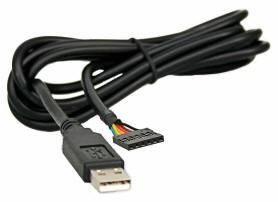Im not sure what type of 'cable' that is.. a link on it?
I 'have' used cell phone data cables....
the problem with this is.. some/most do NOT have the RESET/DTR pin broken out for auto-reset..
which means you'll have to manually push the reset button (timing the bootloader process0 to be able to upload sketches/code to your board..
IF your board has a USB port.. you will NOT need the FTDI cable..
I had posted to the FTDI cable "I" use and recommend..

and.. (again).. as stated MANY MANY MANY times before in this thread.. DO NOT USE 9v (rectangle) batteries!.. they are complete JUNK!..
IMHO.. you are not getting enough current to your servo's.. do like everyone else has said..
1.) use a 'real' battery pack/source.. either a bench top power supply. or a +7.4v li-ion pack or something..
2.) it 'looks' like you may be doing this.. but ensure you have the GNDs connected..
I 'think' you have the GND rail from right side of the breadboard.. going to the LED row.. then to the GND rail on the left side of the breadboard?
hard to tell with the blue wires..
3.) I dont see ANY resistor on that led (you must hate the little guy?)

IMHO.. set up the breadboard FIRST...
meaning..
attach battery pack (not that one, but a real one).. the same way you have it now..
then take the TWO power rails from the RIGHT side (where the battery pack is connected to)..
and connect those outside rails to the outside power rails on the LEFT side of the board..
now you have a 'powered' proto-board.. that you can add components, and tap the rails for the power..
I would then take a wire from the GND rail on the breadboard and connect it to the Arduino GND pin..
!!!!
Well from the pic,.. your servo's might be dead..
you are NOT regulating the voltage from the 9v battery pack.. you have connected the servo's directly to it..
most servo's can ONLY take +4.8v - +6v (maybes yours are different?)
some rules of thumb.
ALWAYS use a resistor with LEDS (always!.....yes, always)

read up on the parts/components you plan on working with, under their limitations and requirements.... (ie: operating voltage/current..etc) (get familiar with their datasheets.. yes, they suck and are cryptic.. but eventually they will get easier to read and yield good information)
it LOOSK liek you have the +3.3v pin on the Arduino conected to the left side power rail on the breadboard?.. why? (dont do that)

the only thing on the breadboard that should be connected to the Arduino is:
1.) the GND rail (not POS rail)
2.) 1 wire to the button
3.) 1 wire to servo 1 (not really the breadboard but still)
4.) 1 wire to servo 2 (not really the breadboard but still)
5.) 1 wire to the LED
thats 5 wires.. (I count 6 on yours)

again this is from a pic.. and I could be wrong.. so explain if I have something in-correct on my interpretation


